M
I
C
R
O
S
T
O
R
Y
O
F
A
R
T
........................................................

NOW COMPLETED:

........................................................
MICROSTORY OF ART
ONLINE JOURNAL FOR ART, CONNOISSEURSHIP
AND CULTURAL JOURNALISM
........................................................
INDEX | PINBOARD | MICROSTORIES |
FEATURES | SPECIAL EDITIONS |
HISTORY AND THEORY OF ATTRIBUTION |
ETHNOGRAPHY OF CONNOISSEURSHIP |
SEARCH

........................................................



 >MICROSTORIES
>MICROSTORIES
- Richard Serra
- Martin Scorsese
- Claude Simon
- Sunshine
- Werner Herzog
- The Creation
- Marcel Duchamp
- Nino Rota
- Wölfflin and Woolf
- Hansjörg Schneider
- Kraftort Arkadien
- Visual Biography
- Schlaraffenleben
- Die Geisteswissenschaften
- The Voyeur
- Buzzword Sustainability
- Paul Verlaine
- Tao Yuanming
- New Beginning
- Seneca
- Still Lifes
- Charles Baudelaire
- Frédéric Chopin
- The Art History of Sustainability
- Wang Wei
- Solarpunk
- Historians of Light
- Lepanto
- Renaturalization
- Plates
- Snow in Provence
- Learning to See
- Picasso Dictionaries
- Peach Blossom Spring
- Picasso Tourism
- Tipping Points
- Sviatoslav Richter
- Weather Reports
- Treasure Hunt
- Another Snowscape in Picasso
- Picasso in 2023
- Dragon Veins
- The Gloomy Day
- The Art of the Pentimento
- Reforestation
- The Status of Painting
- Emergency Supply
- Punctuality
- Watching Traffic
- Zhong Kui
- How Painting Survived the 1990s
- Confirmation Bias
- Sustainability and Luxury
- Garage Bands
- Picasso and Artificial Intelligence
- Eyes of Tomorrow
- Picasso in 2023 2
- Gluing Oneself to Something
- Suburbia
- Bamboo
- Sustainability and Carpe Diem 1
- Interviews with Bruegel
- Sustainability and Carpe Diem 2
- Coffee & Sugar
- Bamboo 2
- Picasso in 2023 3
- Sustainability and Carpe Diem 3
- Cherry Orchard
- Old Magazines
- Chance
- Nick Drake
- Harlequin
- The Smartphone & the Art Book
- Atlas Syndrome
- The Kitchen
- Atlas Syndrome 2
- Consideration
- Tori Amos
- School
- Orchard Auctioning Day
- The Hundred Years’ War
- Sócrates
- Chameleon
- Nefertiti Bust
- Picasso as a Computer
- Sunflowers
- Philemon & Baucis
- Ode to the Radio
- Childhood
- Wimmelbild
- Restitution
- Nick Drake 2
- Wishful Thinking
- Sundays
- The Independent Scholar
- September
- The Fisherman by Pirosmani
- Microadventure
- Sociology
- Salvator Mundi
- Chillon
- Appassionata
- Amber
- Homer
- Berlin
- Planet Walk
- Improvisation
- Seeing Picasso
- These Nice Kids
- Robber
- The One
- The Sea Turtle
- Zoo
- Through the Hush
- Wunderkammer
- I Do Not Seek, I Find
- Shopping Mall
- Food Hamper
- The Secretary
- This Gate
- Nor Rainy Day
- House on a Hill
- Beautiful Island
- Second-hand Bookstore
- Flat
- Slap in the Face
- Serra, Wenkenpark
- Apologies
- The Bells
- Nordmann Fir
- Picasso Wanting To Be Poor
- Picasso, Pirosmani
- A Brief History of Sculpture
- 24 Sunsets
- Rusty Phoenix
- Glove
- Wintry Stanza
- A Song
- Like A Beatle
- Catching An Orange
- Solar Bees
- Permaculture

 >FEATURES
>FEATURES
- Van Gogh On Connoisseurship
- Two Museum’s Men
- Ende Pintrix and the City in Flames
- Titian, Leonardo and the Blue Hour
- The Man with the Golden Helmet: a documentation
- Un Jury d’admission à l’expertise
- Learning to See in Hitler’s Munich
- Leonardo da Vinci and Switzerland
- The Blue Hour Continued
- The Blue Hour in Louis Malle
- Kafka in the Blue Hour
- Blue Matisse
- Blue Hours of Hamburg and LA
- A Brief History of the Cranberry
- The Other Liberale in the House
- The Blue Hour in Raphael
- Who Did Invent the Blue Hour?
- Monet on Sustainability
- Velázquez and Sustainability
- The Blue Hour in Guillaume Apollinaire
- Van Gogh on Sustainability
- The Blue Hour in Marcel Proust
- Picasso and Sustainability
- The Contemporary Blue Hour
- The Blue Hour in 1492
- The Blue Hour in Hopper and Rothko
- Hopper and Sustainability
- The Blue Hour in Ecotopia
- The Hour Blue in Joan Mitchell
- Explaining the Twilight
- The Twilight of Thaw
- The Blue Hour in Pierre Bonnard
- Explaining the Twilight 2
- Picasso on Stalin
- Rubens on Sustainability
- The Salvator Mundi in Bruegel and Rubens
- The Blue Hour in Leonardo da Vinci and Poussin
- The Blue Hour in Rimbaud
- Faking the Dawn
- Frost and Thaw in Ilya Ehrenburg
- Picasso, Stalin, Beria
- Picasso, Solzhenitsyn and the Gulag
- Shostakovich on Picasso
- Hélène Parmelin in 1956
- Historians of Picasso Blue
- Picasso Travelling to Moscow 1
- The Blue Hour in Caravaggio
- Picasso Travelling to Moscow 2
- Picasso, the Knife Game and the Unsettling in Art
- Some Notes on Leonardo da Vinci and Slavery
- Picasso Moving to the Swiss Goldcoast
- The Blue Hour in Camus
- The Blue Hour in Symbolism and Surrealism
- Caspar David Friedrich in His Element
- Exhibiting the Northern Light
- Caspar David Friedrich in His Element 2
- Robert Schumann and the History of the Nocturne
- The Blue Hour in Robert Schumann
- Caspar David Friedrich and Sustainability
- The Twilight of Thaw 2
- Multicultural Twilight
- The Blue Hour in Anton Chekhov
- The Blue Hour in Medieval Art
- Twilight Photography
- The Blue Hour in Bob Dylan
- Iconography of Optimism

 >SPECIAL EDITIONS
>SPECIAL EDITIONS
- Visions of Cosmopolis
- Mona Lisa Landscapes
- Turner and Ruskin at Rheinfelden
- Painters On TV & On TV
- Spazzacamini in Art
- A Last Glance at Le Jardin de Daubigny
- The Experimental Cicerone
- A Dictionary of Imaginary Art Historical Works
- Iconography of Blogging
- Begegnung auf dem Münsterplatz
- Cecom
- Das Projekt Visual Apprenticeship
- Those Who See More
- A Fox on Seeing with the Heart
- Sammlung Werner Weisbach
- Daubigny Revisited
- Some Salvator Mundi Microstories
- Some Salvator Mundi Afterthougths
- Some Salvator Mundi Variations
- Some Salvator Mundi Revisions
- A Salvator Mundi Questionnaire
- A Salvator Mundi Puzzle
- Unknown Melzi
- Francis I and the Crown of Charlemagne
- From Amboise to Fontainebleau
- Drones Above Chambord
- Looking Back At Conques
- Flaubert At Fontainebleau
- Images of Imperial Ideology
- The Chronicles of Santa Maria delle Grazie
- Seeing Right Through Someone
- Melzi the Secretary
- Eying Glass
- A Foil to the Mona Lisa
- A Renaissance of the Cartoon
- Sketching a Family Tree
- Venetian Variations
- A Brief History of Digital Restoring
- A Consortium of Painters
- Leonardeschi and Landscape
- A Christ in Profile
- Learning to See in Spanish Milan
- A History of Gestures
- Leonardo and Josquin
- A Renaissance of the Hybrid
- Suida and Heydenreich
- The Watershed
- Three Veils
- From Beginning to End
- Connoisseurship of AI
- Twilight and Enlightenment
- The Blue Hour in Chinese Painting
- Dusk and Dawn at La Californie
- Iconography of Sustainability
- The Blue Hour in Goethe and Stendhal
- The Sky in Verlaine
- The Blue Hour in Paul Klee
- Iconography of Sustainability 2
- The Blue Hour in Charles Baudelaire
- From Bruegel to Solarpunk
- Some Salvator Mundi Documentaries
- Some More Salvator Mundi Monkey Business
- The Windsor Sleeve
- Brigitte Bardot’s Encounter with Picasso
- Art Historians and Historians
- A Salvator Mundi Chronicle
- The Salvator Mundi and the French Revolution
- The Fontainebleau Group
- The Encounter of Harry Truman with Pablo Picasso
- The Fontainebleau Group Continued
- The Windsor Sleeve Continued
- The Salvator Mundi in Early Netherlandish Painting 1
- Some Salvator Mundi Resources
- A New Salvator Mundi Questionnaire
- The Woman in Picasso
- The Yarborough Group
- Melzi, Figino and the Mona Lisa
- The Yarborough Group Continued
- A Salvator Mundi Global History
- The Salvator Mundi in Medieval Art
- The Salvator Mundi in Medieval Art 2
- The Salvator Mundi in Early Netherlandish Painting 2


 >HISTORY AND THEORY OF ATTRIBUTION
>HISTORY AND THEORY OF ATTRIBUTION
- The Mysterious »Donna Laura Minghetti-Leonardo«
- Assorted Demons of Connoisseurship
- Panofsky Meets Morelli
- Discovering the Eye of Sherlock Holmes
- Handling the Left-handed Hatchings Argument
- Visual History of Connoisseurship
- Alexander Perrig
- Connoisseurship in 2666
- What Postmodernity Has Done to Connoisseurship
- Dividing Four Fab Hands
- A Leonardesque Ambassador
- Test Cases in Connoisseurship
- A Raphael Expertise
- How to Tell Titian from Giorgione
- Louise Richter
- The Unique Property in the History of Connoisseurship
- An Expertise by Berenson
- The Book of Expertises
- An Album of Expertises
- An Expertise by Friedländer
- A Salvator Mundi Provenance
- How to Tell Leonardo from Luini
- An Expertise by Crowe and Cavalcaselle
- An Expertise by Bayersdorfer
- An Expertise by Hermann Voss
- An Expertise by Hofstede de Groot
- Leonardeschi Gold Rush
- An Unknown »Vermeer«
- An Expertise by Roberto Longhi
- An Expertise by Federico Zeri
- A Salvator Mundi Geography
- A Salvator Mundi Atlas
- The Bias of Superficiality
- 32 Ways of Looking at a Puzzle
- James Cahill versus Zhang Daqian
- Five Fallacies in Attribution
- On Why Art History Cannot Be Outsourced to Art Dealers
- On Why Artificial Intelligence Has No Place in Connoisseurship
- Salvator Mundi Scholarship in 2016
- Leonardo da Vinci at the Courts
- The Story of the Lost Axe
- The Last Bruegel
- A Titian Questionnaire
- On Where and Why the Salvator Mundi Authentication Did Fail
- The Problem of Deattribution

 >ETHNOGRAPHY OF CONNOISSEURSHIP
>ETHNOGRAPHY OF CONNOISSEURSHIP
MICROSTORY OF ART
ONLINE JOURNAL FOR ART, CONNOISSEURSHIP
AND CULTURAL JOURNALISM
........................................................

***
ARCHIVE AND FURTHER PROJECTS

1) PRINT


***
2) E-PRODUCTIONS


........................................................

........................................................

........................................................
FORTHCOMING:


***
3) VARIA

........................................................

........................................................

........................................................

........................................................

........................................................
***
THE GIOVANNI MORELLI MONOGRAPH

- The Giovanni Morelli Monograph
........................................................
MICROSTORY OF ART
ONLINE JOURNAL FOR ART, CONNOISSEURSHIP AND CULTURAL JOURNALISM
HOME
| MICROSTORY OF ART ONLINE JOURNAL FOR ART, CONNOISSEURSHIP AND CULTURAL JOURNALISM The Virtual Museum of Art Expertise |
The Man with the Golden Helmet 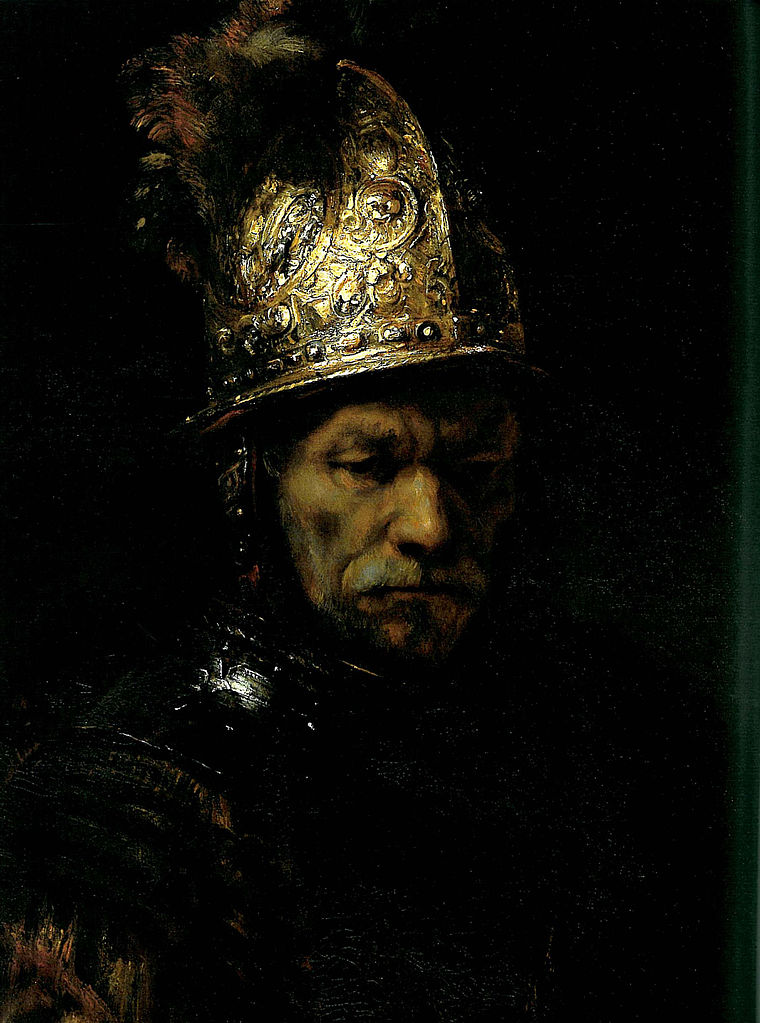   A documentation provided by the Virtual Museum of Art Expertise (Tapestry: galleryhip.com; interior picture above: pinterest.com) |
 What we do here is to assemble some dates from the attributional history as to the famous Der Mann mit dem Goldhelm / The Man with the Golden Helmet (Berlin Gemäldegalerie), once seen as the quintessential and iconic painting by Rembrandt (collectors of silver coins might know it also from there, and under the label of Rembrandt: picture above: colnect.com), but downgraded in 1986 by the museum. The dynamics around this downgrading, however, appear, at least in retrospect, a little bit more complicated and ambivalent. And since we also feel that international audiences might not necessarily be aware what exactly the reasons for this downgrading were (since the documentation was published in German), and since international audiences might also not fully being aware of what experts said when (rather frequently) being interviewed by Berlin newspapers, it seems that the mere dates deserve also a bit of commentary, provided by our museum’s experts. Yet we are not going to take position as to the attribution itself. Thus spoke the helmet, and we may proceed. |
 To set the scenery – two quotations by Ernst van de Wetering (http://en.wikipedia.org/wiki/Ernst_van_de_Wetering) (as quoted by the Berlin daily Der Tagesspiegel in 2006): »Learning meant imitating then. The pupils copied and varied their master.« * »If, all through one’s life, one has seen in the museums authentic and not authentic Rembrandts, hanging side by side, the eye is in some sense polluted. It is, finally, conditioned by certain pictures, as for example the Man with the Golden Helmet.« (»Wenn man sein Leben lang in den Museen echte und nicht echte Rembrandts nebeneinander hängen gesehen hat, dann ist das Auge in gewisser Weise verschmutzt. Es ist schliesslich konditioniert durch bestimmte Bilder, wie zum Beispiel den Mann mit dem Goldhelm.«) |
 Chronicle (pre-1986): 1897: the Berlin Gemäldegalerie acquires the Man with the Golden Helmet 1968: start of the Rembrandt Research Project (RRP) (http://en.wikipedia.org/wiki/Rembrandt_Research_Project ; http://www.rembrandtresearchproject.org) 1969: Rembrandt oeuvre catalogue by Horst Gerson published; according to a 2006 interview Jan Kelch (http://de.wikipedia.org/wiki/Jan_Kelch), the later director of the Berlin Gemäldegalerie, then met with Gerson and heard about his doubts as to the painting’s attribution to Rembrandt; in a review of Gerson’s book the Art historian, editor and dealer Ben Rifkin had questioned the attribution (see also: http://www.garyschwartzarthistorian.nl/schwartzlist/?id=29) [In 2006 Ernst van de Wetering referred to the pre-1986 background of the downgrading of 1986 in the following words (translation: DS, after the transcript of van de Wetering speaking, provided by the daily Der Tagesspiegel in 2006):] »We were most excited then, when being allowed to see this famous work in Berlin, and never the idea would have crossed our mind to question the picture. It was, for us as well, an integral part in the general Rembrandt-image. When in the following the painting was taken out of its frame in the restorer’s workshop our eyes almost fell out of our head. Initially we felt that a de-attribution was absolutely impossible and for years we remained silent, since our insights, until the writing down in the research volumes, were only tentative judgments. Finally the uncertainty in the museum itself grew (up) as to the correctness of the attribution, and in the meantime our doubts had gotten around as well.« (»Wir waren damals ganz aufgeregt, als wir in Berlin dieses berühmte Werk sehen durften und wären nie auf die Idee gekommen, das Bild in Frage zu stellen. Auch für uns war es ein fester Bestandteil im allgemeinen Rembrandt-Bild. Als das Gemälde dann in der Restaurierungswerkstatt aus dem Rahmen genommen wurde, fielen uns fast die Augen aus dem Kopf. Wir hielten eine Abschreibung zunächst für völlig unmöglich und haben jahrelang geschwiegen, denn bis zur Niederschrift in den Forschungsbänden waren unsere Erkenntnisse nur vorläufige Urteile. Schließlich wuchs im Museum selbst die Unsicherheit über die Richtigkeit der Zuschreibung auf, und mittlerweile hatten sich auch unsere Zweifel herumgesprochen.«) (source: tagesspiegel.de; http://www.tagesspiegel.de/zeitung/das-prinzip-der-kennerschaft/679394.html) Pre-1986: the new technology of Neutronenautoradiografie (http://de.wikipedia.org/wiki/Neutronenautoradiografie) is applied to investigate the painting * 1986: Jan Kelch (Ed.): Der Mann mit dem Goldhelm. Eine Dokumentation der Gemäldegalerie in Zusammenarbeit mit dem Rathgen-Forschungslabor SMPK und dem Hahn-Meitner-Institut Berlin, Berlin 1986 (as for the reasons for the de-attribution see below) * Chronicle (post-1986): What is striking in reviewing the post-1986 attributional history (ignored, by the way, by the silver coin of 2010) is the asymmetry between the attributional authority that journalists and probably also the general public have attributed to the Berlin museum’s experts, in comparison to the much larger attributional authority that journalists tend to attribute in this case to the RRP. Since the de-attribution occured, if we take Ernst van de Wetering by the word, after the doubts of the RRP had gotten around, but it occured on the authority of the museum. And only afterwards this de-attribution has been backed by the RRP and especially by Rembrandt expert Ernst van de Wetering (and still in 2006). And one might attempt to evaluate now the weight of the RRP volumes (five are now online: http://www.rembrandtdatabase.org/Rembrandt/cms/corpus), in comparison to the not all too much known 1986 German documentation. But provocatively we might also ask our readers: If the de-attribution of the Man with the Golden Helmet was, as everybody seems to assume, the most famous de-attribution on authority of the RRP – where on earth has this de-attribution actually been documented by the RRP? Or does the Man actually represent the blind spot of the RRP volumes, since the painting is not given to Rembrandt any longer and therefore does not occur within these volumes at all? Find out for yourselves (or see again: http://www.garyschwartzarthistorian.nl/schwartzlist/?id=29). 1991: Rembrandt exhibition Der Meister und seine Werkstatt at Amsterdam, Berlin, London (see for example: http://www.zeit.de/1991/39/rembrandt-reduziert-na-und) 1993: publication of an anti-downgrading booklet by Vadim Moroz and Monika S. Peretz-Moroz (accompanied also by an anti-downgrading New York performance) 2000: a helmet that possibly served as the model for the helmet in the picture has been found 2006: Ernst van de Wetering speaks about his experiences in and with the RRP to the Berlin daily Der Tagesspiegel; Jan Kelch is also being interviewed by Der Tagesspiegel and speaks about the Man with the Golden Helmet as well as about the RRP 2010: a silver coin attributes the Man with the Golden Helmet again (or still) to Rembrandt 2011: on my visit the plaque to the Man with the Golden Helmet said »Rembrandt, Umkreis« and as a date was given »Um 1650/55« (this as a hint to all those wanting to work with the RRP volumes; and compare also what I am saying with what Gary Schwartz has to say: http://www.garyschwartzarthistorian.nl/schwartzlist/?id=29) 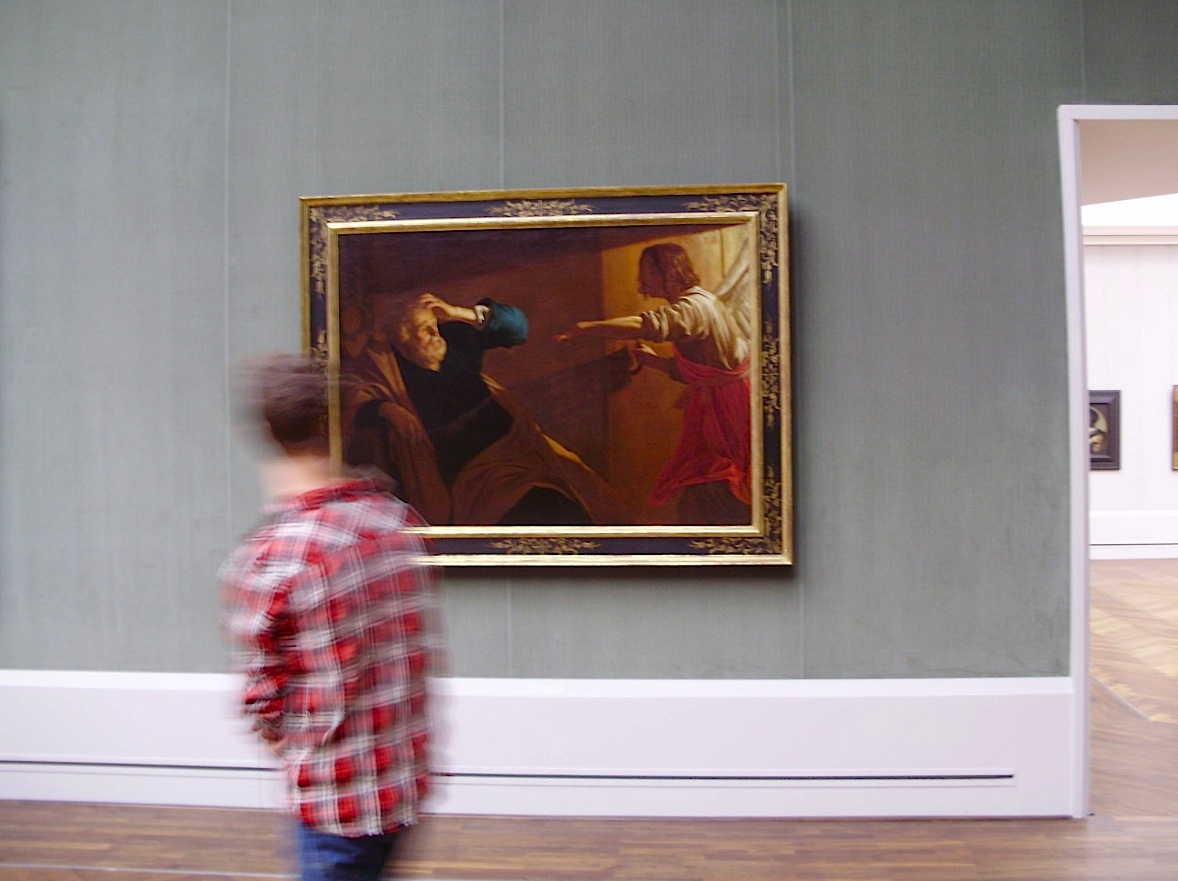 In Berlin Gemäldegalerie (Picture: DS; room with Gerard van Honthorst, Die Befreiung Petri) |
| MICROSTORY OF ART ONLINE JOURNAL FOR ART, CONNOISSEURSHIP AND CULTURAL JOURNALISM Reasons for the De-attribution 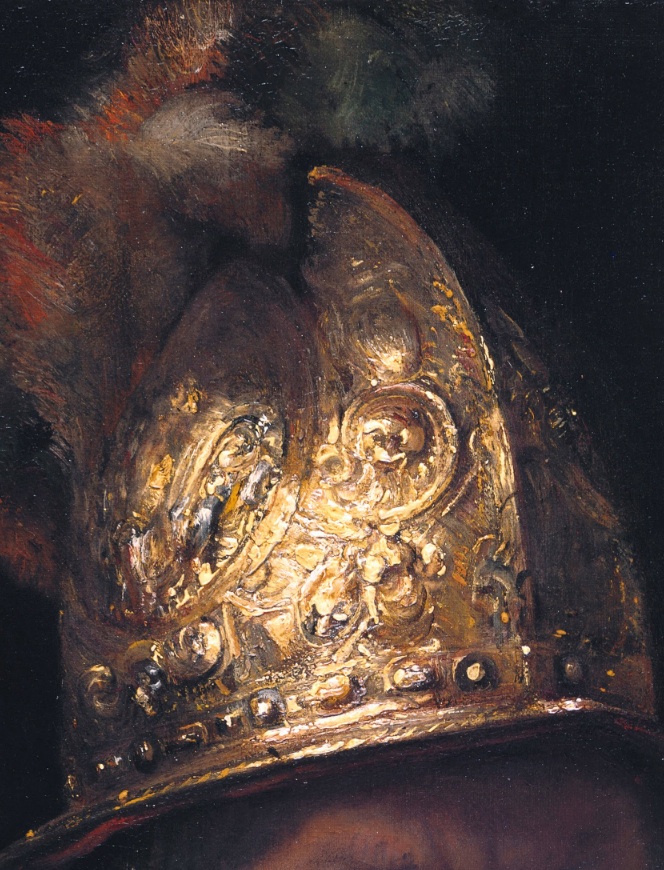 (all detail pictures here: Google Art Project/Wikipedia) ONE) Inconsistency: the ›pastose helmet as an isolated trademark‹ argument‹: »The helmet is not only painted here, but color has been used as a modelling compound. The helmet bulges out sculpturally. The late Rembrandt did love such effects. Yet he has not stand them for themselves, but has them remain aspects of a consistently organized whole. This differenciation does make it. The Golden Helmet-picture, by contrast, has developed from a figural picture into another genre. By the efforts of the yet unknown painter to emulate Rembrandt’s technique of impasto it has become the still life of a splendour helmet.« (»Der Helm ist hier nicht nur gemalt, sondern Farbe ist auch als Modellierungssubstanz eingesetzt. Der Helm tritt plastisch hervor. Der späte Rembrandt hat solche Effekte geliebt. Er lässt sie jedoch nicht isoliert, sondern sie bleiben Aspekte eines einheitlich gestalteten Ganzen. Diese Differenzierung macht es. Das Goldhelm-Bild ist dagegen vom Figurenbild in eine andere Gattung geraten. Im Bemühen des noch unbekannten Malers, Rembrandts Impastotechnik nachzuahmen, ist es zum Stillleben eines Prunkhelmes geworden.«) Jan Kelch (source: interview, as published in Der Tagesspiegel in 2006; http://www.tagesspiegel.de/zeitung/jemand-von-nebenan/679344.html) 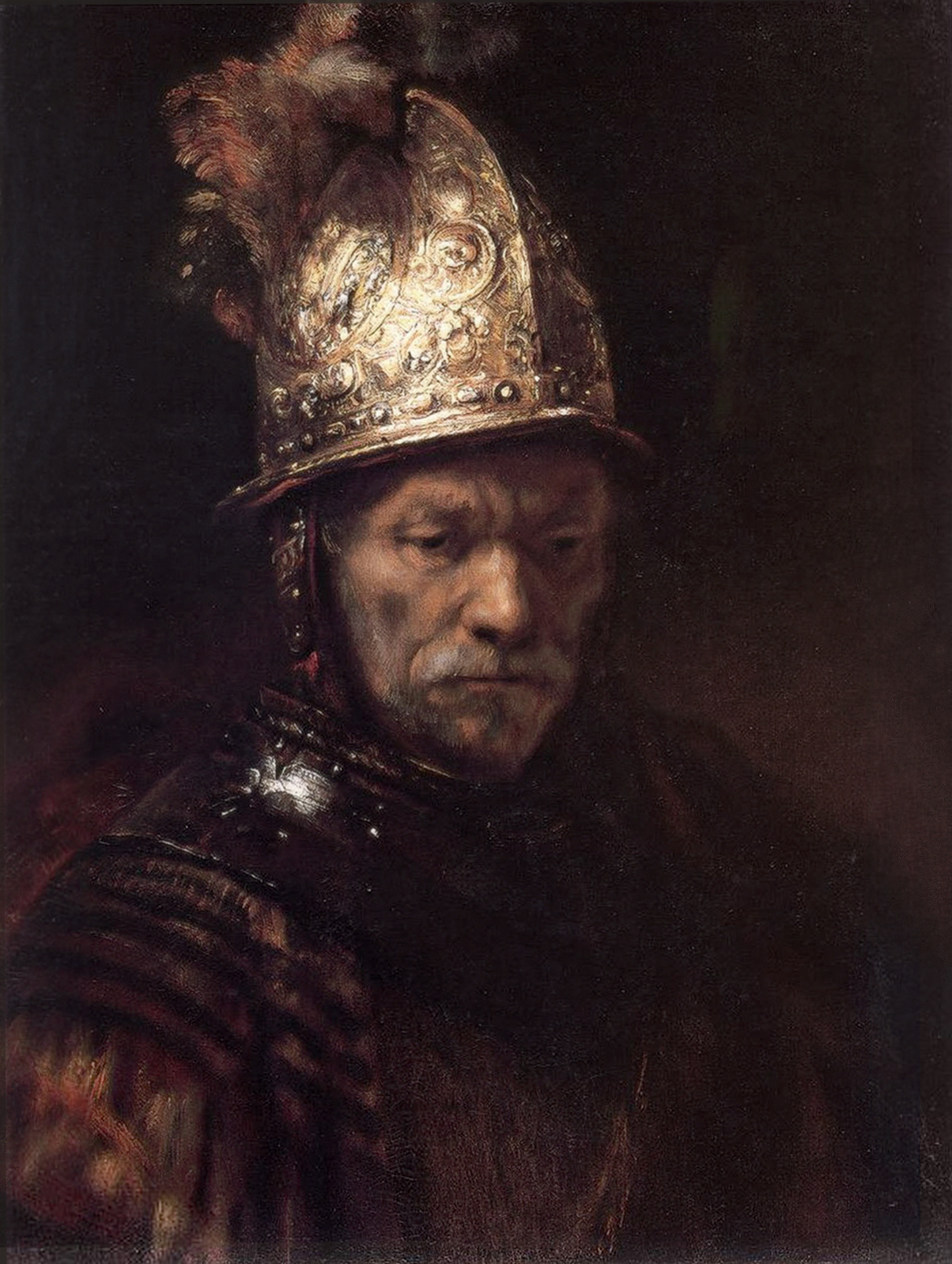 TWO) The ›dashed‹ brushwork in the sitter’s face: not Rembrandt’s ›handwriting‹ 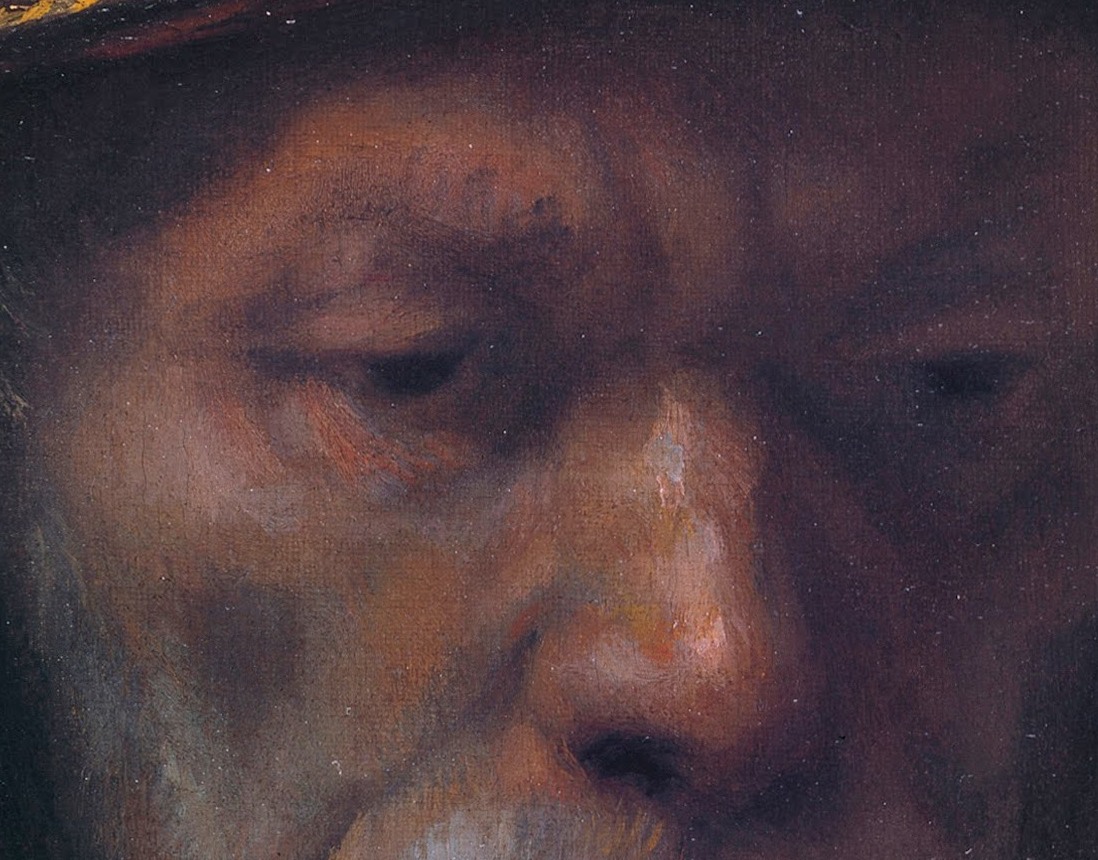 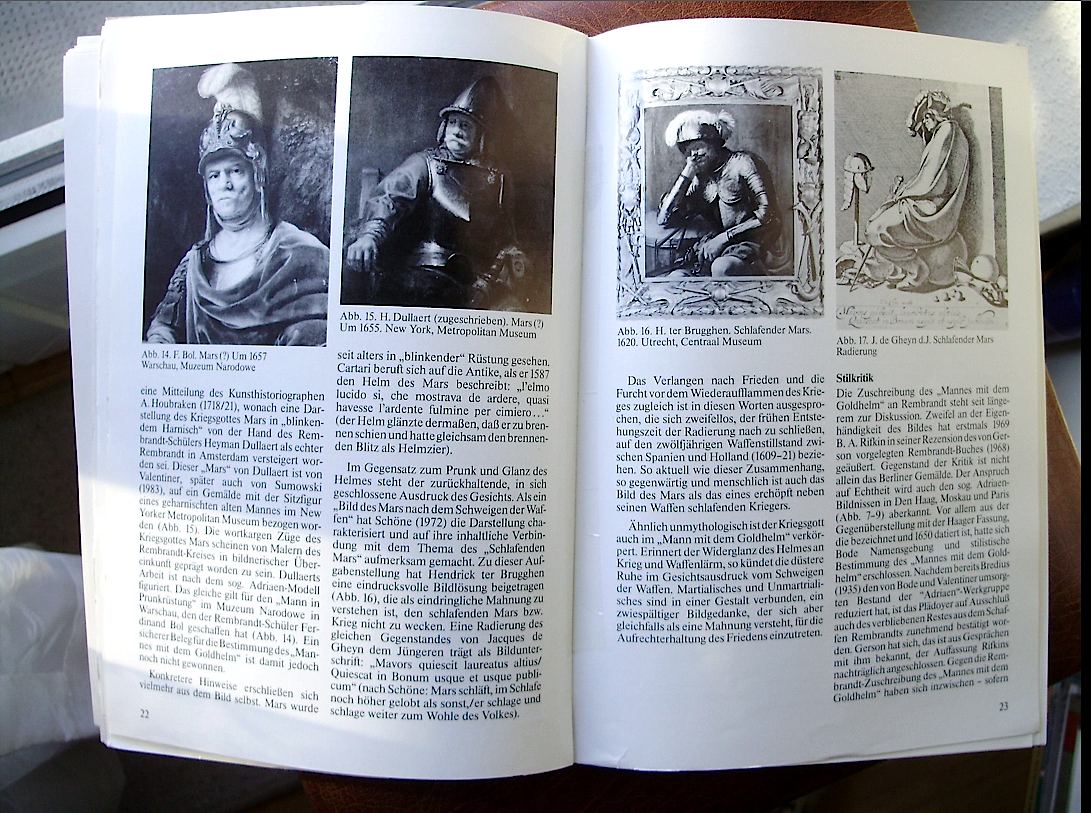 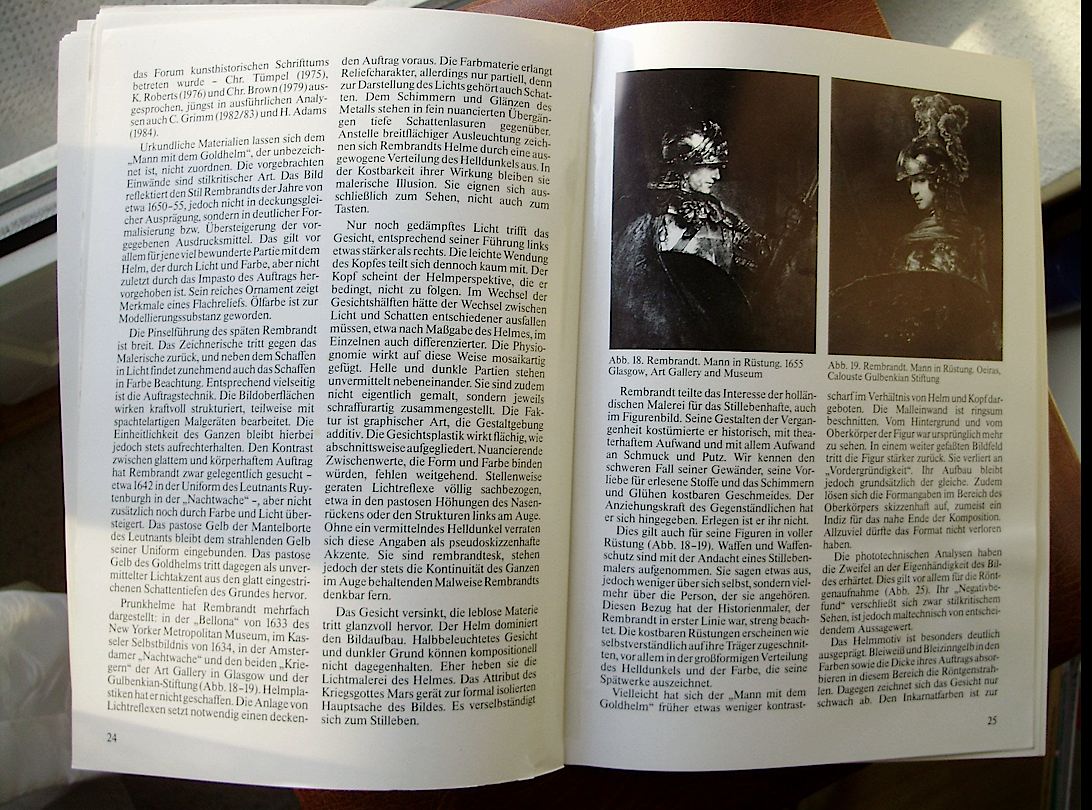 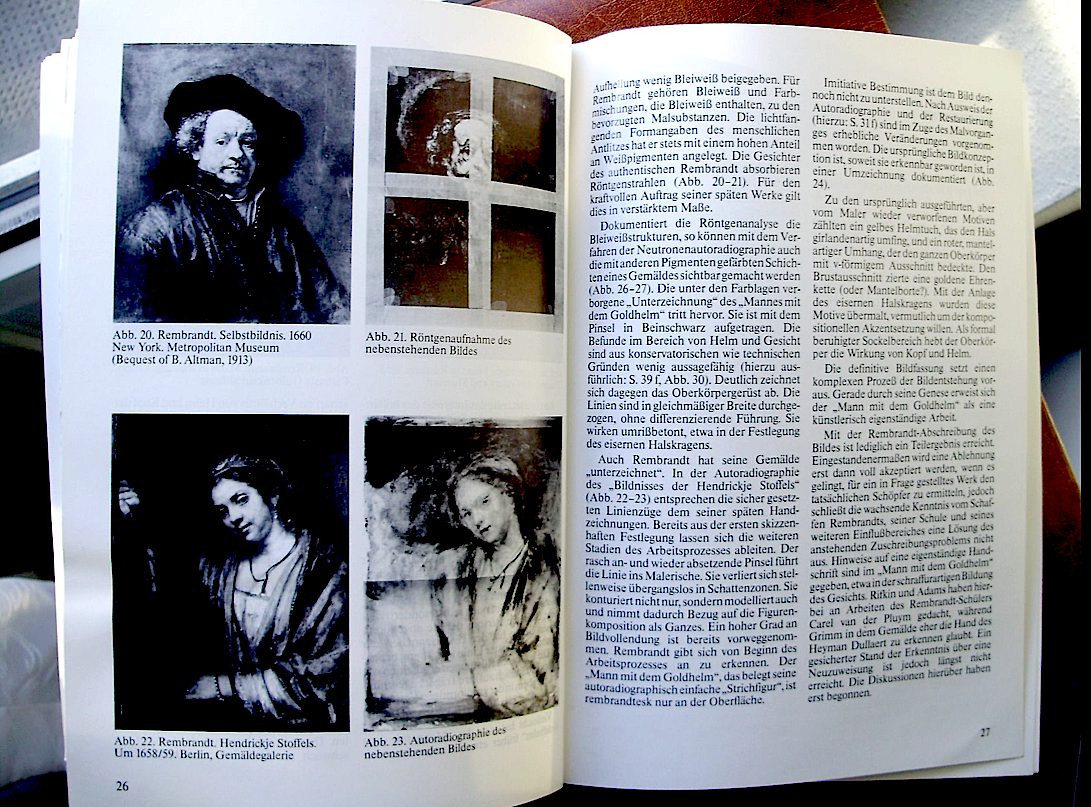 The reasoning in its elaborated form (Pictures: DS; 1986 brochure) THREE) The very simple underdrawing (whereas Rembrandt can be recognized ›from the beginning‹) 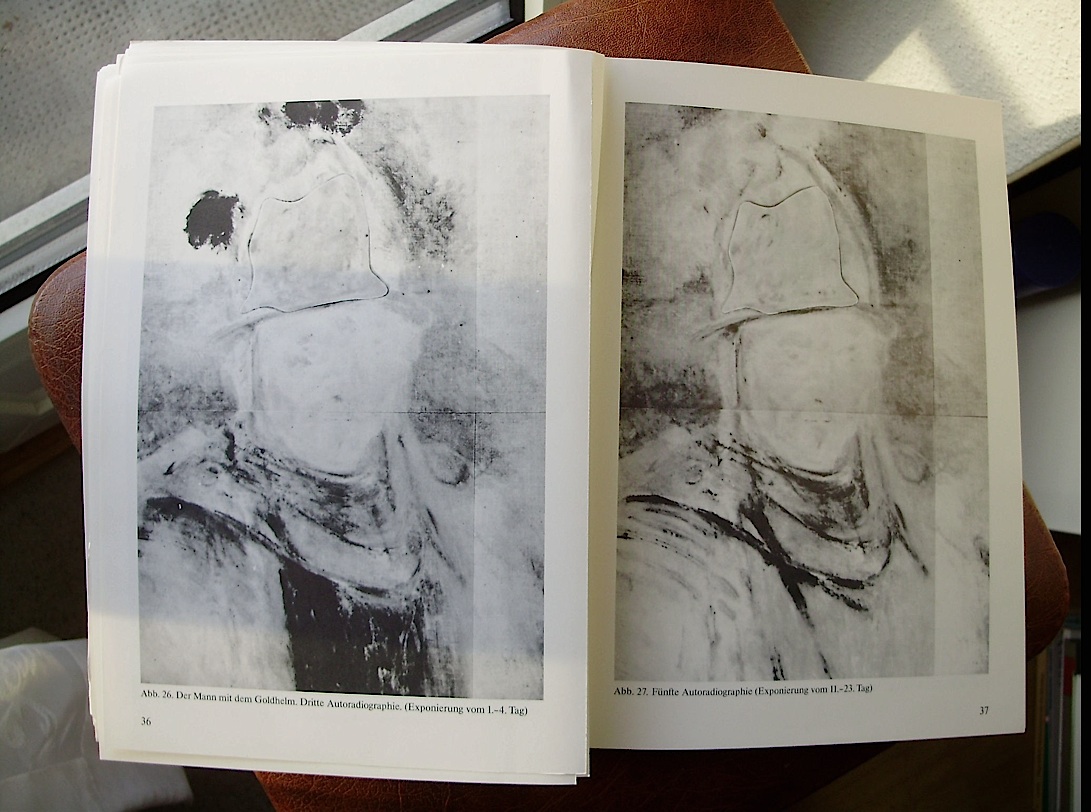 (Picture: DS; please consult the 1986 brochure; these pictures only do reflect my working with it)  |
A Supplement: Michael Jackson recognizes the Man with the Golden Helmet (and does not care about the attribution) (and also a supplement to my ›Michael Jackson’s visit at the Basel Kunstmuseum‹ snippet; see: http://www.seybold.ch/Dietrich/MichaelJackson) »Eine kuriose Geschichte: Michael Jacksons Besuch in der Gemäldegalerie vor drei Jahren. Er kannte nur zwei Künstlernamen, Raffael und Rembrandt. Vorrangig fragte er nach biblischen Gestalten. Zuerst wollte er Abraham sehen, auch seinen Namenspatron, den Erzengel Michael, dann war es Moses – da waren wir schon bei Rembrandt. Den Mann mit dem Goldhelm hat Jackson sofort wiedererkannt, denn sein Vater besass eine Reproduktion des Bildes. Ob es ein Rembrandt ist oder nicht, interessierte nicht. Jackson ist ein erstaunlich frommer Mann und ziemlich bibelfest. Den Moses hat er sich selbst erklärt. Als ich ihn fragte, was ihn an dem Bild so fasziniert, antwortete er: »It’s crazy: He looks like Charlton Heston.« Das stimmt, obwohl Heston, als er die Rolle des Moses in den Zehn Geboten spielte, noch ein junger Mann war. So alt wie der Waffenlobbyist inzwischen ist, sieht er dem Moses noch ähnlicher. Ich bin fast sicher, wenn Heston im 17. Jahrhundert in Amsterdam über die Strasse gegangen wäre und Rembrandt ihn gesehen hätte, hätte er gesagt: Komm mit, ich brauche dich als Modell.« (source: Jan Kelch; as above)  (Picture: pinterest.com) |
| MICROSTORY OF ART ONLINE JOURNAL FOR ART, CONNOISSEURSHIP AND CULTURAL JOURNALISM The Virtual Museum of Art Expertise Thank you for visiting |
MICROSTORY OF ART
ONLINE JOURNAL FOR ART, CONNOISSEURSHIP AND CULTURAL JOURNALISM
HOME
© DS